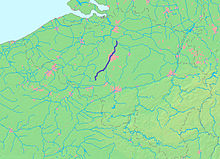Senne (Dijle)
| Senne | ||
|
The herdsman in Rebecq |
||
| Data | ||
| location | Belgium ; Provinces of Hainaut , Walloon Brabant , Flemish Brabant and Antwerp , as well as the Brussels-Capital Region | |
| River system | Scheldt | |
| Drain over | Dijle → Rupel → Scheldt → North Sea | |
| source | in Naast | |
| Source height | 123 m | |
| muzzle | in Heffen in die Dijle coordinates: 51 ° 3 '53 " N , 4 ° 25' 47" E 51 ° 3 '53 " N , 4 ° 25' 47" E |
|
| Mouth height | 5 m | |
| Height difference | 118 m | |
| Bottom slope | 1.1 ‰ | |
| length | 103 km | |
| Catchment area | 1164 km² | |
| Drain |
MQ |
5.5 m³ / s |
| Big cities | Brussels | |
| Communities | Soignies , Rebecq , Tubize , Halle , Beersel , Drogenbos , Forest / Vorst , Anderlecht , Saint-Gilles / Sint-Gillis , Molenbeek-Saint-Jean / Sint-Jans-Molenbeek , Laken , Schaerbeek / Schaarbeek , Evere , Vilvoorde , Zemst | |
The Senne (French) or Zenne (Dutch) is a 103 km long river in central Belgium , which has its source southeast of Soignies in the province of Hainaut, flows through Brussels and flows into the Dijle south of Antwerp . She will u. a. fed by the Maelbeek and the Woluwe and is an indirect tributary of the Scheldt via Dijle and Rupel .
ecology
In the center of Brussels, it was completely built over during the 19th and 20th centuries. However, it is still visible in the surrounding area and outside the urban area. As a shipping route, it was replaced by the Charleroi-Brussels Canal , which was partially built into its floodplain .
In the wetlands along the river mainly thrives iris (Iris). The iris was therefore chosen as the coat of arms of the Brussels-Capital Region.
The Senne became known as one of the most polluted rivers in Europe, as the faeces of around two million people and the sewage from hundreds of factories in the greater Brussels area were discharged directly into the river. Since the commissioning of an additional sewage treatment plant in Haren in March 2007, the water quality has improved. Until 2007, the wastewater from the factories and the faeces of the more than one million inhabitants of the greater Brussels area flowed untreated into the rivers and further into the North Sea. After the first problems with the city's new but untried sewage treatment plant on November 25, 2009, the treatment plant was shut down completely in December. Due to the great public turmoil, the plant was put back into operation 10 days later.
See also
Web links
Individual evidence
- ↑ An unsolved case , on greenpeace-magazin.de
- ↑ Veolia and the collapse of the Brussels sewage treatment plant , on wasser-in-buergerhand.de


